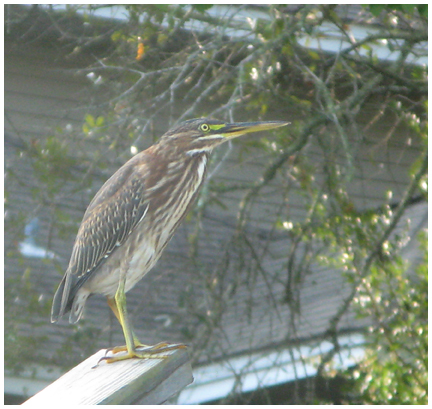Is this an American Bittern or a Green Heron?

This beauty, was spotted perched on a dock along Lake Powell Sept. 6.
American Bittern (Botaurus lentiginosus)
Sun-gazer, the American bittern is called, as well as Stake Driver, Thunder Pump and Mire Drum. The names refer to the bittern’s call, a deep resonant oonk-a-lunk, which has been likened to the bellowing of a bull or a hydraulic machine. It’s odd that a bird this secretive makes such a racket.
Since the bittern is a winter visitor to Florida, we rarely hear its weird vocalizations, mostly made during the spring and summer.
But we can see its effective use of camouflage. The bittern, a species of heron, spends its life among tall, aquatic vegetation like cattails or sawgrass, in freshwater and saltwater marshes or at the borders of lakes. It stands over two feet tall. Its color – a buffy brown back, creamy underparts with brown flecking, greenish legs – allows it to blend with the surroundings, as does its behavior. To remain concealed when alarmed, the bird freezes with its head pointed skyward, resembling reeds. If wind stirs the vegetation, the bittern may also sway its head.
They occur throughout Florida November through April, mostly in freshwater juncus marshes, before returning to the northern U.S. and southern Canada to breed. Their numbers have been declining over the past three decades at an average rate of 2.4 percent per year, mostly due to loss of wetlands.
To see an American bittern, then, is luck indeed.
Green heron (Butorides virescens)
Identification Tips:
• Length: 14 inches Wingspan: 25 inches
• Sexes similar
• Small, short-legged and short-necked heron
• Yellow legs
• Tucks neck in close to body in flight and often at rest, rarely extending it
• Black cap
• Blue-gray back and wings
Adult: Chestnut neck, white chin, white stripe down center of neck
Information courtesy FWC.

DP in AZ
September 6, 2009I’m not an avid birder, but this looks more like a Green Heron. We see a lot of them down here in the Phoenix area.
Walton Outdoors
September 6, 2009You could be right! They look so similar… !
Carole Goodyear, President, Choctawhatchee Audubon Society
September 8, 2009The bird pictured is a young green heron. This species breeds in our area’s marshes and brushy shorelines and is commonly seen during summer. The American bittern, on the other hand, is a rare visitor in winter. It is about 60% larger and lighter brown than the green heron.
Walton Outdoors
September 8, 2009Thank you Carole!